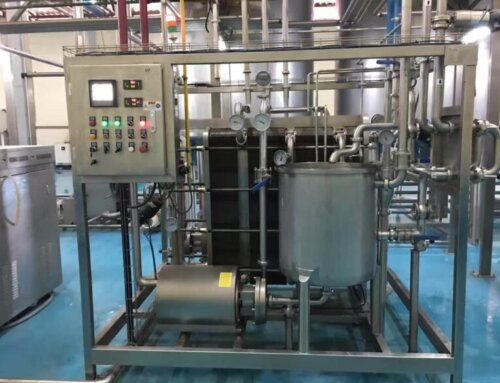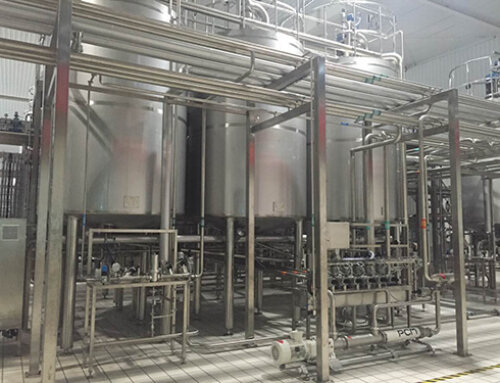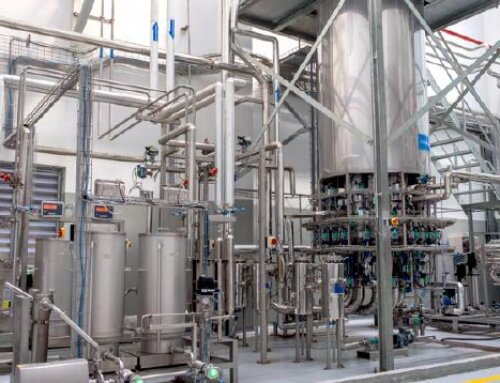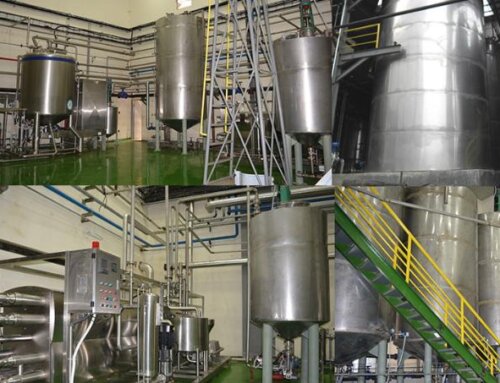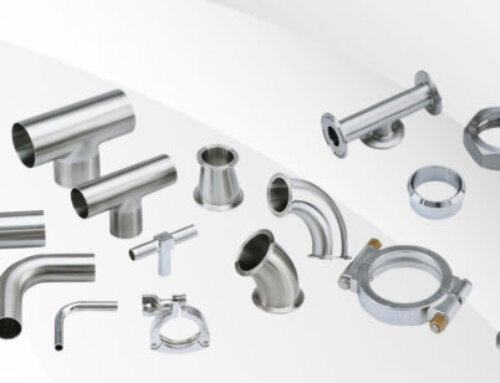ESL Milk Production Line Description
ESL milk is short for extended shelf life milk. ESL milk has a longer shelf life than pasteurized milk by improving the sterilization process and hygiene level of filling equipment, which can reach 7-15 days to 21 -60 days.
ESL milk is essentially a product between pasteurized milk and UHT milk. Compared with ordinary pasteurized milk, the sterilization intensity is higher, the ultra-pasteurized method is adopted, and the typical sterilization process is 125-130℃/2-4S, in addition to higher heat treatment temperature, there are usually stricter hygienic requirements for filling machines and filling environments. However, ESL milk is not aseptically filled as UHT milk, so it is also not a commercial aseptic product, and can not be stored and transported at room temperature.
The ESL milk production process mainly includes raw milk receiving system, milk purification, homogenizing, HTST sterilizing and degassing, milk batch storage and cold filling system, cold chain storage and chilled distribution for the ESL milk with 4℃.
The ESL processing technology can also be used for producing plant-based milk, NFC juice, flavored milk, fermented products, etc. to make the end products has a longer and more stable shelf life.
The ESL milk production plant capacity is from 500LPH-10000LPH available for clients to choose from, and the end products can be filled into gable top cartons, glass bottles or PP/PET bottles and pouches.
The ESL milk filling, packing, storage, transportation and sales distribution temperature needs to control at 4℃, and the shelf life of the end products varies from 7 days-60 days according to different processing conditions and clients’ requirements.

ESL Milk Processing Machine Introduction
Raw milk receiving system
The receiving of raw milk mainly includes the detection and acceptance of the color, odor, microorganisms, nutrients and other indicators of raw milk, After the acceptance is qualified, the raw milk is collected, cooled, stored, filtered, homogenized, etc. Because ESL milk has strict requirements on the shelf life of the end product, it is extremely important to check the quality of the raw milk. Processes including later storage and filtration require strict control of the number of microorganisms.
The main equipment used in this system is raw milk receiving and storage tank, plate cooler, milk cooling tank, centrifugal separator, milk degasser, homogenizers and milk standardization tank. All these equipment are made of SUS304 material and meet the requirements of food hygiene and safety.

Milk HTST Pasteurizing system
In ESL milk production process, there are 3 methods for milk pasteurization and bacteria removal:
HTST heat treatment pasteurization:
ESL milk is also called ultra-pasteurized milk, so the pasteurization process is the core part of the whole ESL milk production line. The classic pasteurization process for ESL milk is 125-130℃ for 3-5S. The aim for pasteurizing/sterilizing ESL milk is to inactivate vegetative bacteria and spores of psychrotrophic bacteria, and to cause minimal chemical change that can result in cooked flavor during heat treatment.
The heating systems used for ESL processing are of two major types, direct and indirect. In a direct system(DSI sterilizing system), heating occurs through direct contact between steam and the product, and in an indirect system(Tubular or Plate HTST pasteurization system), the heat is transferred to the product from steam or hot water through a heat exchanger.
Disk centrifuge separator bacteria removing+plate pasteurization heat treatment:
The “sterilization” of a disk centrifuge refers to the removal of a portion of large particle impurities, clots, cell fragments, spores, fungi or some bacteria from the liquid through physical separation, thereby reducing the number of microorganisms and achieving a certain “purification” or “pre-sterilization” effect, the milk after the disk centrifuge clarifier, 80% bacteria and 95% Spore fungus will be removed, then the milk will be heat treatment by the plate pasteurizer(75-85℃ for 15S), after heat treatment, the 99% bacteria will be removed, and only about 5% Spore fungus residule in milk, so it can extend the shelf life efficiently.
Micro-filtration bacteria removing+plate pasteurizer heat treatment:
Microfiltration sterilization uses membrane materials with precise pore sizes (generally 0.1-1.0 microns) to filter microorganisms (bacteria, yeast, mold) and suspended particles in liquids to achieve the purpose of sterilization and purification. In the case of milk, microfiltration can remove up to 99% of bacteria and spores. This is usually followed by a plate pasteurizer for mild heat treatment, further reducing bacterial residues. As a result, the shelf life of the final product is extended, while nutrients and flavor are largely preserved due to the reduced thermal load.

ESL milk filling system
In a filling machine used in connection with an ESL processing solution, everything that can come in contact with the product needs to be disinfected or sterilized, even the air in the filling chamber. To ensure the ESL milk has a stable shelf life, the following measures need to be taken:
—The milk-filling process is carried out in a clean room, and the air in the clean room is filtered by HEPA filters, so it is a highly clean area.
—The packaging materials like bottles, caps or cartons need to be sterilized by H202 solution or UV lights to ensure the materials are clean and have no bacteria residue.
—The filling operator needs to operate the machine according to SOP and strict training should be carried out before employment.
—The milk filling temperature should be controlled below 4°C.
—The filling system must do CIP cleaning regularly.

Factors Affecting ESL Milk Quality and Shelf Life
Raw milk quality
The quality of raw milk has an important impact on the quality of ESL milk. In addition to physical and chemical indicators such as fat and protein, it also includes the total number of bacteria, the number of somatic cells, and antibiotic residues. In order to ensure the stability and long shelf life of ESL milk, controlling the quality of raw milk is an important part, and the most important factors are microorganisms and somatic cells.
—Microorganism
The number of bacteria in raw milk is an important factor affecting the shelf life of ESL milk. The psychrophilic bacteria in the raw milk can produce heat-resistant enzymes under low-temperature conditions, which can cause product acid bags, peculiar smells, whey separation, discoloration, coagulation, stickiness and other deterioration phenomena. When the number of microorganisms in the raw milk reaches a certain amount, especially when it exceeds 10/mL, some bacillus such as Bacillus megaterium, Bacillus stearothermophilus, etc. cannot be completely killed, and are easily activated during storage, resulting in product deterioration. In the production of ESL milk, the total number of bacteria in raw milk should be controlled within 5×10/mL, and the number of spores should be controlled within 5×10/mL.
—Somatic cells
The number of somatic cells in milk is an important indicator of cow udder health. In recent years, many European and American countries have adopted the number of somatic cells as one of the criteria for purchasing raw milk. Experiments show that when measuring HSCC (high somatic cell) milk and LSCC (low somatic cell) milk with the same fat content after standardization. After pasteurization, homogenization, packaging and refrigeration (5°C) under the same conditions, the increase in free fatty acids in HSCC milk was found to be 2 to 3 times higher than that in LSCC milk. In the later stage of refrigeration, HSCC milk will have obvious fatty acid spoilage, the acidity is significantly higher than that of LSCC milk, the taste has obviously unclean taste, and the aftertaste is bitter, which indicates that the high somatic cell count has a greater impact on the taste and shelf life of milk. Therefore, in the production of ESL milk, while the number of raw milk bacteria is guaranteed, raw milk with low SCC should also be selected for processing to ensure the quality of the product.
Raw milk heat treatment method and filling method
Different heat treatment methods have different effects on the shelf life of ESL milk. In the UK, ESL milk is pasteurized at 90°C and hold for 5S, and transported to an ultra-clean filling machine for packaging, capping, and the filling machine is thoroughly decontaminated , the shelf life of the obtained ESL milk under refrigerated conditions is up to 30 days. According to American standards, it is sterilized at least 72°C for 15s. ESL milk has a shelf life of 7 to 14 days. After sterilization at 138°C for 2s, it is filled with an ultra-clean filling machine, and the container and cap are also sterilized. The shelf life of its products is 60 days. The formulation of ESL milk sterilization conditions should not only take into account that the number of microorganisms in milk can be significantly reduced, but also minimize the changes in product sensory quality due to heat treatment.
Improving hygiene conditions from processing to the filling can improve product hygiene. ESL milk is not required to be packaged under aseptic conditions, heat-resistant microorganisms still exist in pasteurized milk, especially when the distribution temperature is increased, the shelf life is significantly shortened. Therefore, ESL dairy products are generally kept in a low-temperature environment during storage, transportation and sales.
Packaging materials
In order to reduce pollution, the packaging materials of ESL milk should be sterilized and sterilized before filling, and the materials should have good resistance to oxygen penetration and light resistance. Because both oxidation reactions and sunlight can lead to fat spoilage and vitamin oxidation in milk, resulting in unpleasant flavor and reducing nutritional content, it has a great impact on the shelf life of milk.
Cold chain system
The cold chain system is extremely important for the preservation and sale of ESL milk. When the storage temperature is increased by 3°C, the shelf life of milk will be shortened by 50%. A perfect cold chain system requires cold storage warehouse, cold chain transport vehicles, developed transportation system. Therefore, ESL milk products have become mainstream in developed countries in Europe and America due to the mature cold chain transportation system. However, in most developing countries, there is a big opportunity for developing ESL milk products because the low-temperature transportation system is not very sound, and ESL milk must be produced under strict hygienic raw milk, special sterilization methods and lower temperature conditions.
